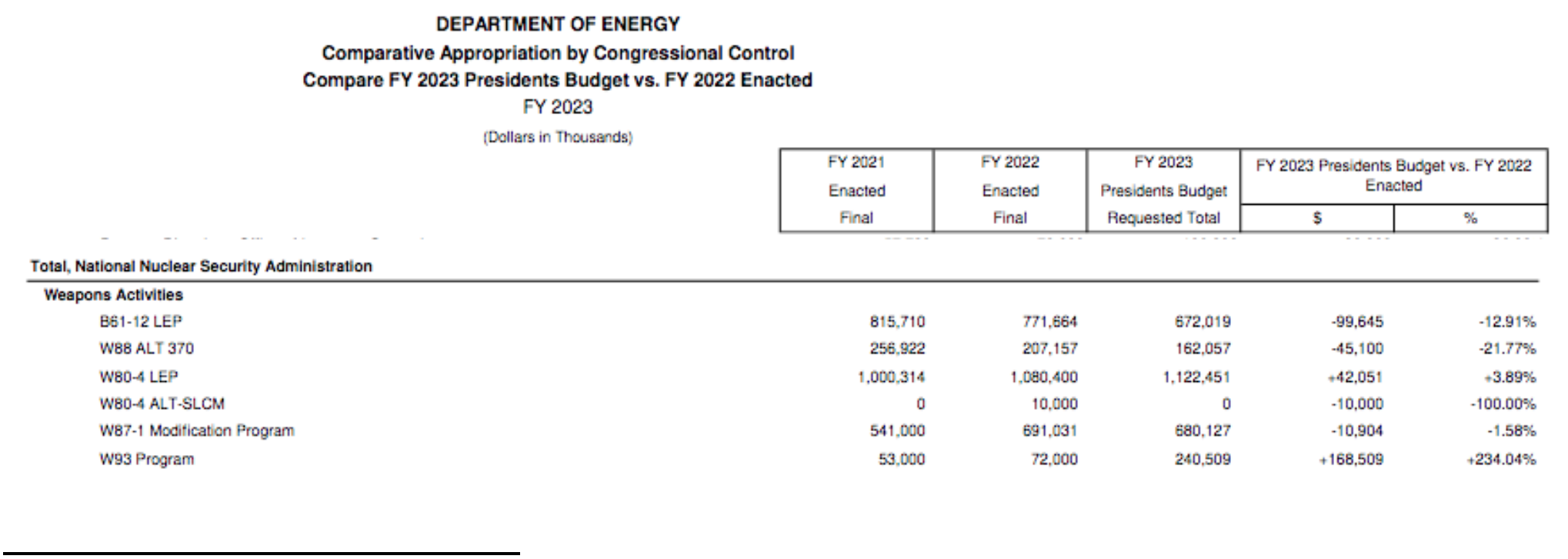The W93 warhead is a proposed new-design submarine-launched nuclear weapon for the Navy. Its need is not clear given that the Navy’s W76 warhead recently completed a major “Life Extension Program” that extended its service life by at least 30 years and increased its accuracy through a new arming, fuzing and firing set. The Navy’s other sublaunched warhead, the W88, is entering a major “Alteration” which will refresh its conventional high explosives and give it a new arming, fuzing and firing set (presumably increasing its accuracy as well).
The National Nuclear Security Administration’s (NNSA’s) FY 2023 Congressional Budget Request clearly links the United Kingdom with the W93. For example, “The UK is participating as observers in the US W93/Mk7 warhead program” and “W93 Program …. • Coordinate with the UK on their Replacement Warhead.” 1 The United Kingdom is known to be a key driver behind the W93 and has explicitly lobbied Congress for it. As background, the UK reportedly has a parts problem for its version of the American W76 warhead, but obviously a new-design warhead is not necessarily needed to solve a parts problem.2
Proposed funding for the W93 in FY 2023 is more than doubled

Exploding Costs for the W93 in Future Years

The above W93 costs are for design and feasibility studies. NNSA has not yet said whether the W93 will require new plutonium pits, which it probably will. To date the costs for new pit production has not been included in the W87-1 warhead, the first to require new pits. NNSA’s last publicly available cost estimate for pit production over 30 years was in 2018 for $42 billion. However, since then the estimated costs for the Savannah River Plutonium Processing Facility has more than doubled to $11 billion. Given typical cost overruns, NNSA’s pit production over 30 years will likely cost around $60 billion. So far, pit production costs are not included in NNSA’s cost estimates for new-design warheads, which is illogical given that the plutonium pit is the all-important primary or “trigger” for modern thermonuclear weapons.
Further, no future pit production is scheduled to maintain the safety and reliability of the existing nuclear weapons stockpile – instead it is all for speculative new designs. Independent experts have found that pits have reliable lifetimes of at least a hundred years and more than 15,000 existing pits are already stored. Future pits will likely be heavily modified from tested designs. These new pits cannot be full-scale tested because of the existing testing moratorium, thereby perhaps eroding confidence in stockpile reliability. Or, perhaps worse yet, it could prompt the U.S. back into testing, which would have severe international proliferation consequences.
Other Future New-Design Warheads
The National Nuclear Security Administration makes clear the range of new-design nuclear weapons that it is planning for in its congressionally-required annual Stockpile Stewardship and Management Plan:
“2.2.8 Future Warheads DOE/NNSA is coordinating with DoD to define the appropriate ballistic missile warheads to support threats anticipated in 2030 and beyond. These warheads currently include the Future Strategic Land-Based Warhead, the Future Strategic SeaBased Warhead, the Future Air-Delivered Warhead, and a Submarine-Launched 4 NNSA FY 2023 Congressional Budget Request, Weapons Activities, PDF page 18, https://www.energy.gov/sites/default/files/2022-04/doe-fy2023-budget-volume-1-nnsa-wa-v2.pdf Nuclear Watch New Mexico • W93 and Other Future New-Design Nuclear Weapons 3 Warhead (for the W76-1/2) that will be needed in the 2040s. These plans are notional and may be subject to change.” 5
Suffice it to say, this is a never-ending parade of costly uncertain new designs when the U.S. already has an extensively tested nuclear weapons stockpile that has been proven to be highly reliable.
